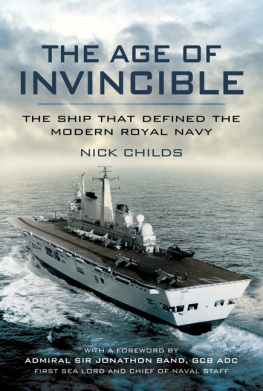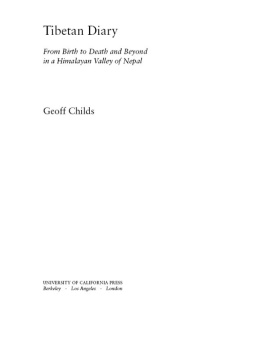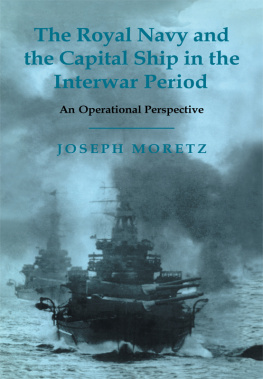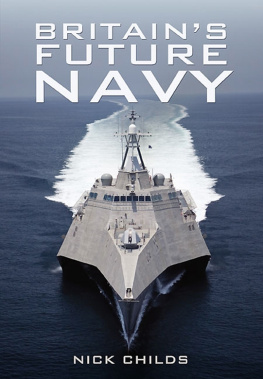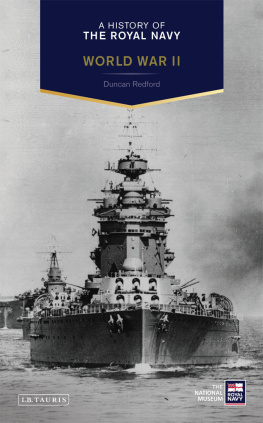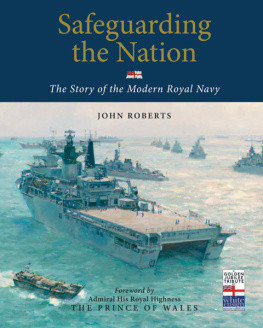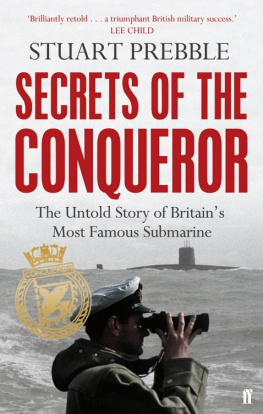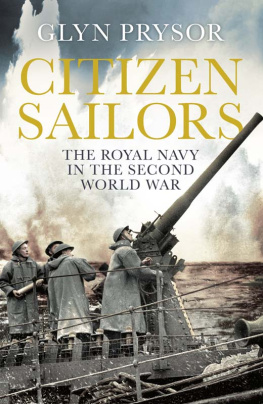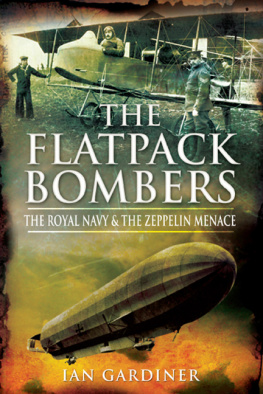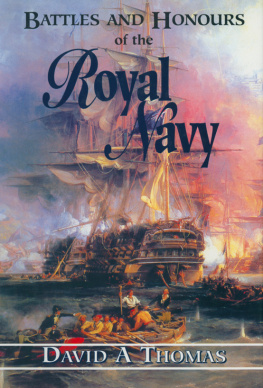
Contents
List of Plates
Acknowledgements
A s a teenager in the 1970s, with an already well-developed interest in the Royal Navy, I grew up with artists impressions depicting HMS Invincible as the shape of things to come. Now she is in the twilight of retirement. I must start by thanking the Royal Navy for its help in compiling this story of her career and times, in particular Captain Mike Davis-Marks and Lieutenant Commander Harvey Burwin of Defence Public Relations (Navy). Through their good offices, it was a great privilege for me to be able to speak to the Navys most senior serving officers, the First Sea Lord, Admiral Sir Jonathon Band, the then Commander-in-Chief Fleet (and former Invincible commanding officer) Admiral Sir James Burnell-Nugent, and his successor, Admiral Sir Mark Stanhope, as well as the then Assistant Chief of the Naval Staff, Rear Admiral Alan Massey. Thanks are also due to the officers and crew of HMS Illustrious , who welcomed me aboard to demonstrate how the Navys carriers have evolved. In an even greater dazzle of gold braid, I was also most grateful and privileged that some of the most distinguished former First Sea Lords of the modern era agreed to talk to me:Admiral of the Fleet Sir Henry Leach, Admiral of the Fleet Sir Julian Oswald, and Admiral Sir Jock Slater. I was also fortunate that Invincible is blessed with a very strong First Commission Wardroom Association, many of whose members also responded enthusiastically to my project. The other former Invincible commanding officers who kindly gave up their time and memories were Admiral Sir Jeremy Black, Vice Admiral Sir Fabian Malbon, Rear Admiral Roy Clare, and Admiral Sir Ian Forbes. Other eminent former naval persons whose experience and knowledge I happily plundered included Admiral Sir Raymond Lygo, Admiral Sir James Eberle, Vice Admiral Sir Jeremy Blackham, and Rear Admiral Richard Hill. From the world of naval architecture, Professor David Andrews of University College, London, Professor Louis Rydill, and Arthur Honnor all gave their perspectives on the events recorded here. From the world of politics, Lord Owen and Sir John Nott kindly offered their reflections, as did some of the countrys most distinguished civil servants in the defence field, Sir Patrick Nairne, Sir Michael Quinlan, Alistair Jaffray, and Sir David Omand. Professors Eric Grove and Gwyn Prins gave much focus to my thoughts. My researches were also greatly aided by Captain Christopher Page, Dr Malcolm Llewellyn-Jones, and the staff of the Naval Historical Branch, Graham Mottram and the staff of the Fleet Air Arm Museum, and Edward Hampshire at the National Archives, Kew. Thanks, in different ways, are due to the naval commentators and analysts Dr Norman Friedman, Richard Scott, Michael Codner, Jason Alderwick, and posthumously Antony Preston, who was a friend for many years with an infectious interest in all matters naval. Of course, I would not have had the excuse to inflict myself on this great armada of naval expertise without Pen & Sword, and especially my editor, Philip Sidnell, who gave me the chance to write this tale of an emblematic ship. Thanks also to David Stanford for scrutinizing the manuscript. And, finally, to my wife, Jill, for her loyal support, encouragement, and advice.
Foreword
I was fortunate enough to command HMS Illustrious in the mid-nineties which saw a period of continual change and concluded with the Ocean Wave Global Carrier deployment in 1997. The Invincible class was a product of the 1966 Wilson Governments cancellation of the CVA-01 aircraft carrier programme. The CVA-01 decision was precipitated by a change in foreign policy that dictated a withdrawal of national interest East of Suez which was the main argument for sea- based air power at the time. The result was the loss of independent power projection by the UK and a refocusing of defence priorities on the heartland of NATOs central front shaped by Cold War threats. The RAF were to provide air defence to the Fleet in conjunction with surface-to-air missile systems in new destroyers.
Within this smaller role for the Royal Navy, CVS was originally designed to accommodate twelve anti-submarine helicopters as defence against a large Soviet submarine force assessed as the main threat to the NATO alliance at sea. The offensive capability of the navy was to rest in its nuclear submarine fleet and amphibious capability deployed to protect NATOs northern flank.
The Soviets invested heavily in long range patrol aircraft such as the Tu-95 Bear. RAF interceptors could not meet response times which put surface units at risk from long range anti-ship missiles, most notably amphibious shipping. To counter this threat the Sea Harrier was born, increasing the CVS aircraft complement to seventeen.
The 1981 Nott Defence White Paper directed a swathe of cuts in the naval order of battle including amphibious shipping and the sale of Invincible to Australia. 1982 highlighted the white papers erroneous assumption as Invincible and our amphibious forces became the bedrock for success in the Falklands. Another lesson re-learnt was the lack of organic airborne early warning (AEW) resulting in the loss of six ships. Post conflict, 849 Squadron re-commissioned with AEW Sea Kings and Invincible s air group swelled to 21.
By 1991 the Soviet Union and Warsaw Pact had collapsed Options for Change heralded the promise of a defence dividend. 1991 also saw the first Gulf War and the beginning of an unpredictable world after the Cold Wars relative stability. The Balkans conflict, increased tensions in Iraq and the Kosovo War followed in quick succession with an Invincible-class ship always present.
The RAFs Harrier force had lost its raison detre with the fall of the Berlin Wall and became vulnerable to defence restructuring that followed. New Labours Strategic Defence Review resulted in the formation of Joint Force Harrier (JFH); this drew together the strengths of land-based and maritime-based aircrew expertise. Concluding that an expeditionary force structure required assured combat air power, the UK once again committed to carrier air power thirty-two years after the cancellation of CVA-01. Sierra Leone in 2000 witnessed an amphibious operation, supported by JFH embarked in Illustrious . The next year Illustrious was conducting Exercise Saif Sareea off Oman when New Yorks Twin Towers were struck. The US response was swift with a surprise attack from the sea and Illustrious was re-configured with CH-47 Chinooks to deploy Special Forces into the mountains of Afghanistan.
As Nick Childs amply demonstrates in this excellent and very readable account of the life of one of the Royal Navys most significant modern warships and the worlds from which she sprung and into which she emerged, the Age of Invincible can be summarised as one of continual change. Designed for one role, developed for another within a Cold War strategic context, Invincible was pivotal for air power provision during the Falklands War and grew to accommodate a variety of global tensions spawned from the collapse of the Soviet era and ensuing unforeseen conflict areas. An agile ship in every respect, she has demonstrated the range of effects that aircraft carriers provide. Her gift was to extol the virtues of carrier air power and give the compelling operational evidence for CVF. Now and in future years UK forces on can be assured of air power provision at a time and place of military and political choice. CVF will be a Joint Defence asset, fit for the twenty-first century and at the heart of expeditionary operations this will require an education process. Wielding significant influence amongst our US and European allies she will offer military planners a wider range of options and effects against potential threats to UK interests.
Next page
